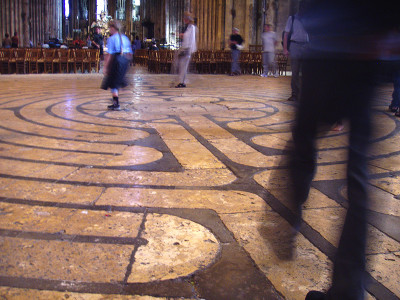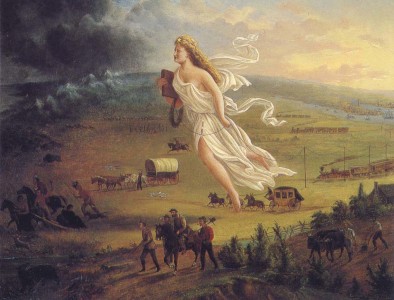
My recent immersion in ancient Egyptian art (for A Cat Out of Egypt) has reminded me of the many hours I’ve spent roaming happily through the art of the Ancient Near East–as far back in human history as the Stone Age years (roughly 50,000 to 10,000 BCE). Just in surveying the history of Egypt, I’ve traveled through so many cultures so quickly that thoughts on the nature of cultural change have finally stopped me in my tracks. So today I want to share with you some of my wandering thoughts on time, change, and Western culture, born of encounters with the work of long-dead artists.
 Before Einstein turned science on its head, people in Western culture tended to picture time as a single line which connected the beginning and end of all things. This is no longer the case, at least among scientists. The idea of linear time emerged from the early cultures of the Ancient Near East and was essential to Judaism’s understanding of reality. Judeo-Christian culture embraced linear time as its own, and structured history and reality accordingly. Wherever the Church—and later Western culture—extended its influence through colonialism and conversion, linear time was a non-negotiable part of the package.
Before Einstein turned science on its head, people in Western culture tended to picture time as a single line which connected the beginning and end of all things. This is no longer the case, at least among scientists. The idea of linear time emerged from the early cultures of the Ancient Near East and was essential to Judaism’s understanding of reality. Judeo-Christian culture embraced linear time as its own, and structured history and reality accordingly. Wherever the Church—and later Western culture—extended its influence through colonialism and conversion, linear time was a non-negotiable part of the package.

But many cultures prior to Judeo-Christian contact tended toward circular or spiraling ideas of time. These ideas took various forms, from the cyclical rebirth of the entire universe to models more directly reflecting the turning seasons and skies. Cycles of death and rebirth were generally part of these worldviews, but for those of us firmly planted in a linear model of time appreciating these other models can be difficult.
Oddly enough, I can offer an example of time as a circle/spiral from my own experience. I’ve always thought in images. So if I thought of time, I pictured it, just as I did everything else. For as long as I can remember, at least back into my elementary school years, whenever I’ve tried to recall memories in sequential order, I’ve imagined years as circles in an ascending counterclockwise spiral. Winter begins each new circle at the top, moving into spring on the left, summer at the bottom side, and fall on the right, all rising toward a new winter and a new circle on the upward spiral. The spiral’s circles are formed of rather misty mosaics of memory-images from the seasons and events of the year. I offer this example simply to suggest that if a thoroughly Western child of elementary-school years could spontaneously create such a circular model—one that persists on into adulthood alongside a standard linear model of time—then cyclical time might not be all that alien to any of us.

Linear time as the Church concretized it in Christian doctrine defined history as the stage upon which God acted to lead Creation to its divinely ordained conclusion–thus contributing, if indirectly, to the Western idea of progress. Also moving onto the stage at some point was the idea of a divinely chosen people whose own culture set the standard for all other peoples. By the 19th C, Western culture was producing theories of cultural evolution with “primitives” on the bottom and privileged Western society on the top. Immeasurable pain and violence were inflicted on other cultures as a result, and the damage is ongoing today. Although most reputable scholars rejected such ideas of cultural evolution by the mid-20th C, similar notions do still linger in the popular mind. Almost any person raised within a Western worldview is, at the very least, a carrier of embryonic presuppositions regarding progress and “primitivism,” whether they wish to carry them or not. It’s in the air, in our mothers’ milk.

So what does all this have to do with my journeys through ancient art? Well, I found myself asking, “Why do cultures change?” When Stone Age humans began domesticating animals, was it “development,” “progress,” or simply change based on circumstances we can’t see clearly today? Cultural change that led to dynastic civilizations and large-scale warfare can only be called progress (with any certainty) if where we stand today is the intended and best possible result in an overall plan of history. When Neolithic groups moved toward urbanization and the beginnings of metallurgy, was it progress, or simply change? What other paths existed in prehistory as possibilities—what waves had not yet collapsed? In Western Asia and Eastern Europe cultures adhering to traditional ways disappeared—or were wiped out by the widespread wars, plagues, and famines of the last half of the Bronze Age. And here a possibility began to grow in my mind.
 I considered the course of events in recent centuries when Traditional, or Earth-based, cultures encountered Western civilization. One thing I had never considered before now demanded my full attention: African Traditional peoples, Native Americans, South Sea Islanders, Aborigines—these peoples did not progress, or develop, or evolve—their cultures were annihilated. They were not in the process of change when first contact was made. Change was not offered to them as an option. Whether they were killed with weapons, pestilence, starvation, or all three together, their cultures were extinguished. Greed for land and resources, brutally efficient weaponry with the sense of power born of it, and the tantalizing possibility of “might makes right”—these human factors undergirded the conquest of “new worlds.” Would it be unreasonable to suppose that these same human factors sealed the fate of indigenous peoples whose lands adjoined the Fertile Crescent and the civilization it cradled?
I considered the course of events in recent centuries when Traditional, or Earth-based, cultures encountered Western civilization. One thing I had never considered before now demanded my full attention: African Traditional peoples, Native Americans, South Sea Islanders, Aborigines—these peoples did not progress, or develop, or evolve—their cultures were annihilated. They were not in the process of change when first contact was made. Change was not offered to them as an option. Whether they were killed with weapons, pestilence, starvation, or all three together, their cultures were extinguished. Greed for land and resources, brutally efficient weaponry with the sense of power born of it, and the tantalizing possibility of “might makes right”—these human factors undergirded the conquest of “new worlds.” Would it be unreasonable to suppose that these same human factors sealed the fate of indigenous peoples whose lands adjoined the Fertile Crescent and the civilization it cradled?

This line of thought led to disturbing questions often debated among academics—but for me, these questions have become personal. What is progress? Does it really exist? Why is change a good thing, if an existing situation is good already? Is it possible that unlovely traits like greed, abusive power, and fear have always been the most common motive forces in human change?

Now that the Western world is beginning to perceive the number and variety of plagues spawned in its long shadow, some people have begun to look with yearning and regret at Earth’s remaining Indigenous peoples. Unfortunately, when we look we tend to see through the lenses of our own worldview, darkly. We do not see these fellow-humans as people who belong to themselves, with their own lives and concerns, but as solutions to our problems, romanticized projections of our notions of a paradisal age.
Perhaps wisdom remains for the healing of the Earth. Perhaps sustainability is something we can learn. Perhaps if we ask with respect, elders may share their wisdom. But first we of Western culture need to look to our own house.

Beckstet
Professor and historian E. Glenn Hinson first introduced me to the thought of Teilhard de Chardin, a French priest and philosopher of the first half of the 20th century whose reflections on God and history led to repeated censures by the Catholic Church. But the one piece of his thought that burst into my world like a supernova was his assertion that God has given the future of the Earth into human hands: if we don’t take responsibility for our world, God won’t step in with an exasperated sigh and clean up the mess. In the Apostle Paul’s words, we must work out our own salvation with fear and trembling (Phil 2:12). “Progress” does not necessarily reflect God’s will, nor does God necessarily “will” what is happening in our world today. Christ has pointed the way in love, and the Holy Spirit strengthens us as we labor, but if we don’t work for the salvation of all God’s creation, humanity’s end times may be grim indeed.
.
.

